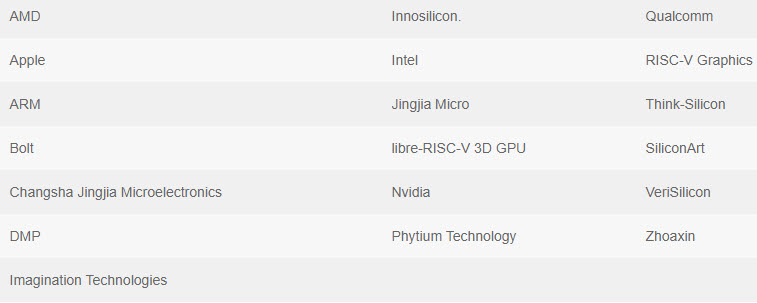The Golden Age of Graphics? The Number of GPU Developers Skyrockets in 2020
Eight new chip developers announced GPU plans last year.
The number of graphics processing units (GPU) developers grew to 19 last year as multiple companies are preparing for looming artificial intelligence (AI), high-performance computing (HPC), and edge computing megatrends, according to an observation by GraphicSpeak, a Jon Peddie Research (JPR) publication. The question is, how many of the started GPU projects will actually come to fruition?
Dozens of companies used to develop discrete graphics processors (dGPUs) in the 1980s and the 1990s, but their number shrank to less than half a dozen by the early 2000s and to two (or three, depending on how you count) later in the decade. By the early 2010s, companies like Arm, Imagination Technologies, DMP, Vivante (now part of VeriSilicon), and Think Silicon (an Applied Materials company) focused purely on GPU IP development (except for DMP). In contrast, companies like Apple and Qualcomm started to design their own integrated graphics processors (iGPUs).
The advent of compute on graphics processing units for AI, HPC, and other highly-parallel workloads, as well as the emergence of multiple new device categories, have spurred significant interest in graphics in recent years. This inspired China-based Jingjia Micro to develop and release the country's first discrete GPU in 2014 and Intel to return to discrete GPU development in 2017.
By late 2019, the number of dGPU, iGPU, and GPU IP developers grew to 11, according to Graphic Speak. Meanwhile, if Tianshu Zhixin (established in 2018) with its Big Island GPGPU chip is included, it grows to 12.
But the interest in GPUs and the ongoing trade war between the U.S. and China inspired many other chip designers to start developing their own GPUs. At least eight new companies announced their GPU plans in 2020. Some of these companies are from China, and some others plan to adopt the open RISC-V architecture. The majority of new entrants are looking to build datacenter-grade solutions rather than consumer GPUs, and companies like Phytium will inevitably address client PCs with their graphics technology, too.
Developing GPUs is a very tricky task. These processors tend to be extremely complex in terms of transistor count, and they also feature distinct subsystems and a multifaceted software stack. It remains to be seen how many of these new GPU projects will actually be a success. Still, it is pretty obvious that with Intel and several new entrants, AMD and Nvidia will face considerably more competition in the next couple of years than they have in the last couple of decades.
Get Tom's Hardware's best news and in-depth reviews, straight to your inbox.

Anton Shilov is a contributing writer at Tom’s Hardware. Over the past couple of decades, he has covered everything from CPUs and GPUs to supercomputers and from modern process technologies and latest fab tools to high-tech industry trends.
-
spongiemaster It sure is the golden age, Without a stock pile of gold, you're aren't going to be buying anything.Reply -
Matt_ogu812 Both graphic cards and gold are just as elusive.Reply
How can there be a golden age of graphics cards, be so many developers but no products to sell?
Are these developers building them for themselves? -
d0x360 There is zero chance I would ever put chinese hardware like a cpu or gpu in my pc. Hardware level malware that can't be detected just doesn't sound appealing to me.Reply

